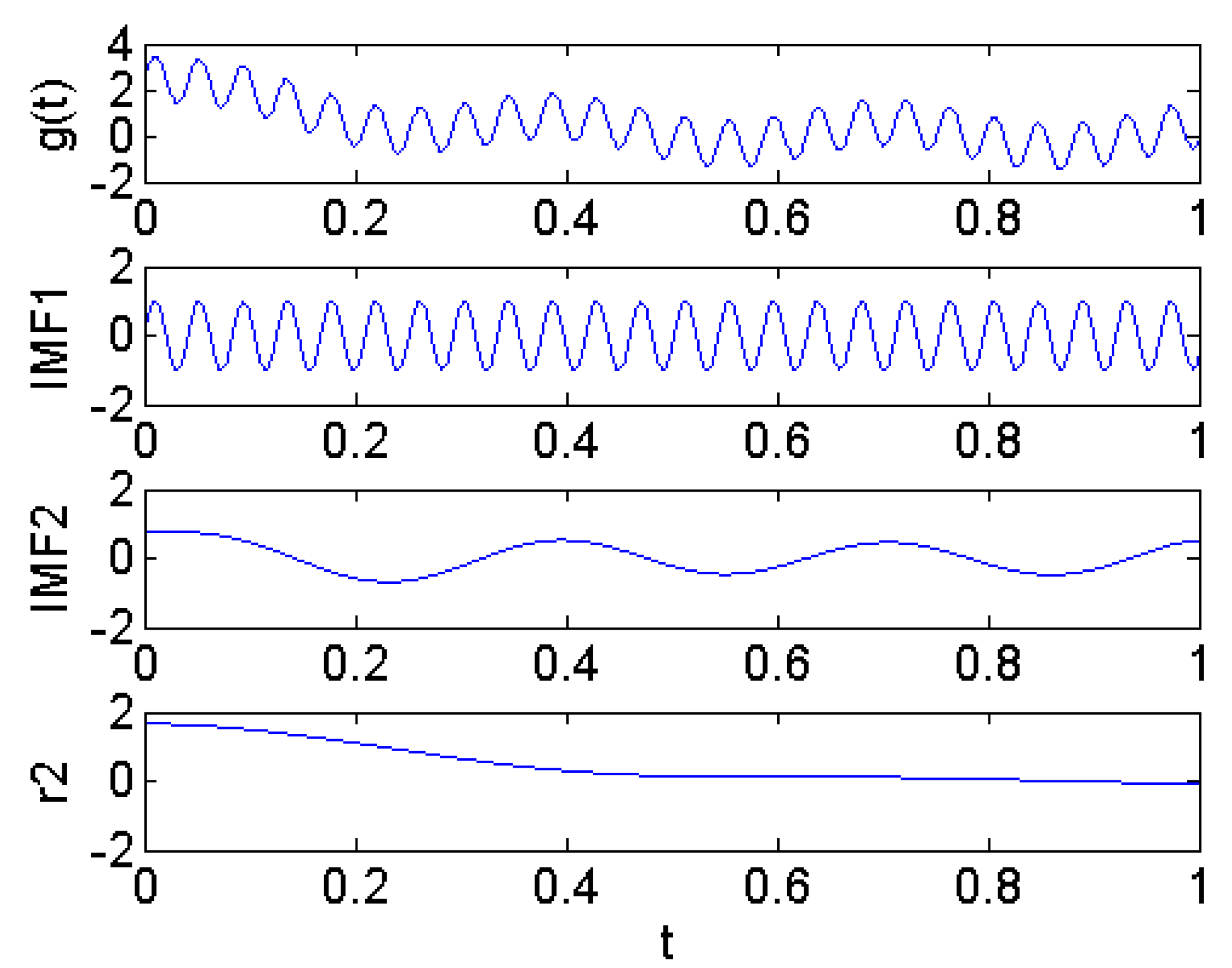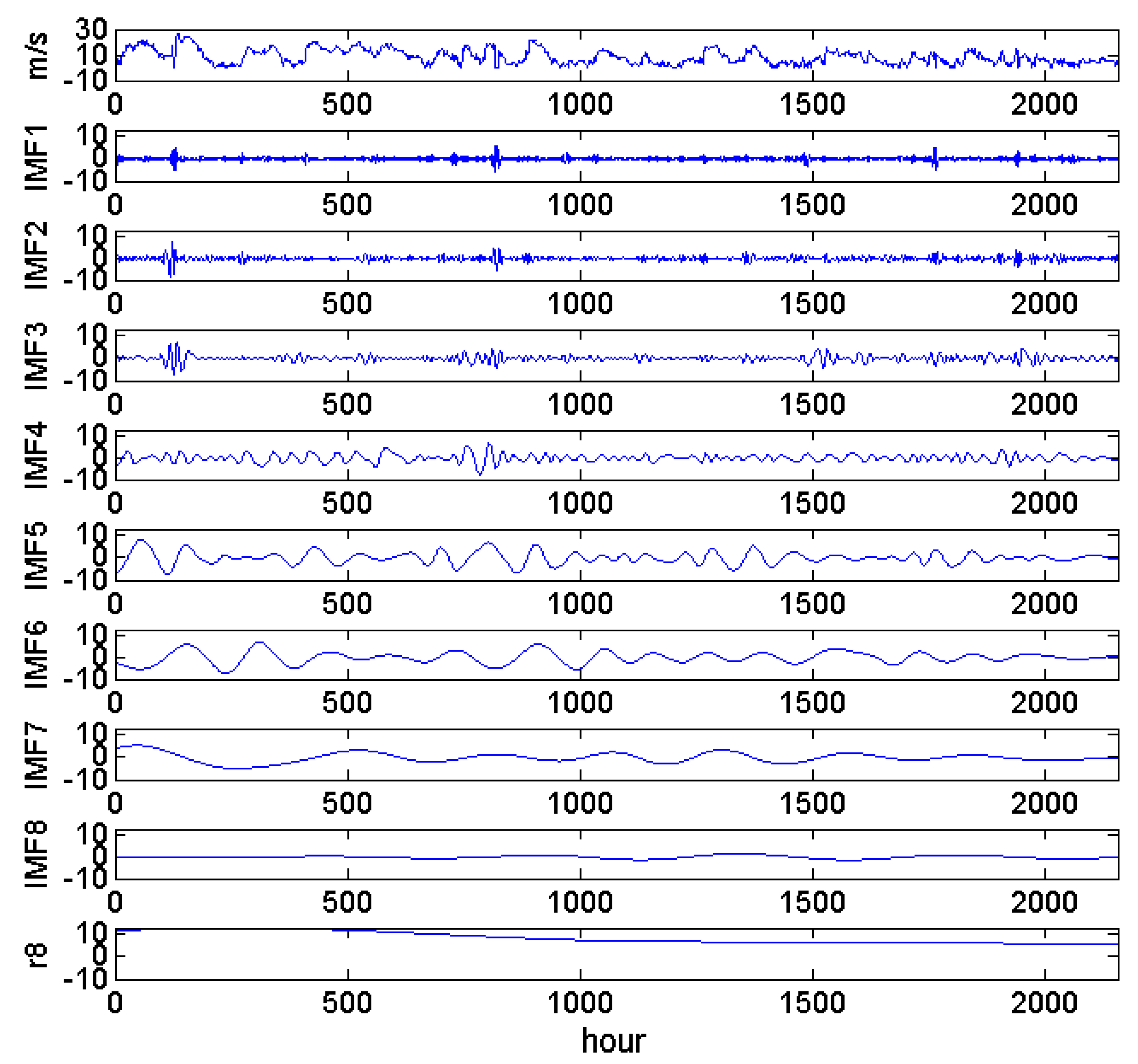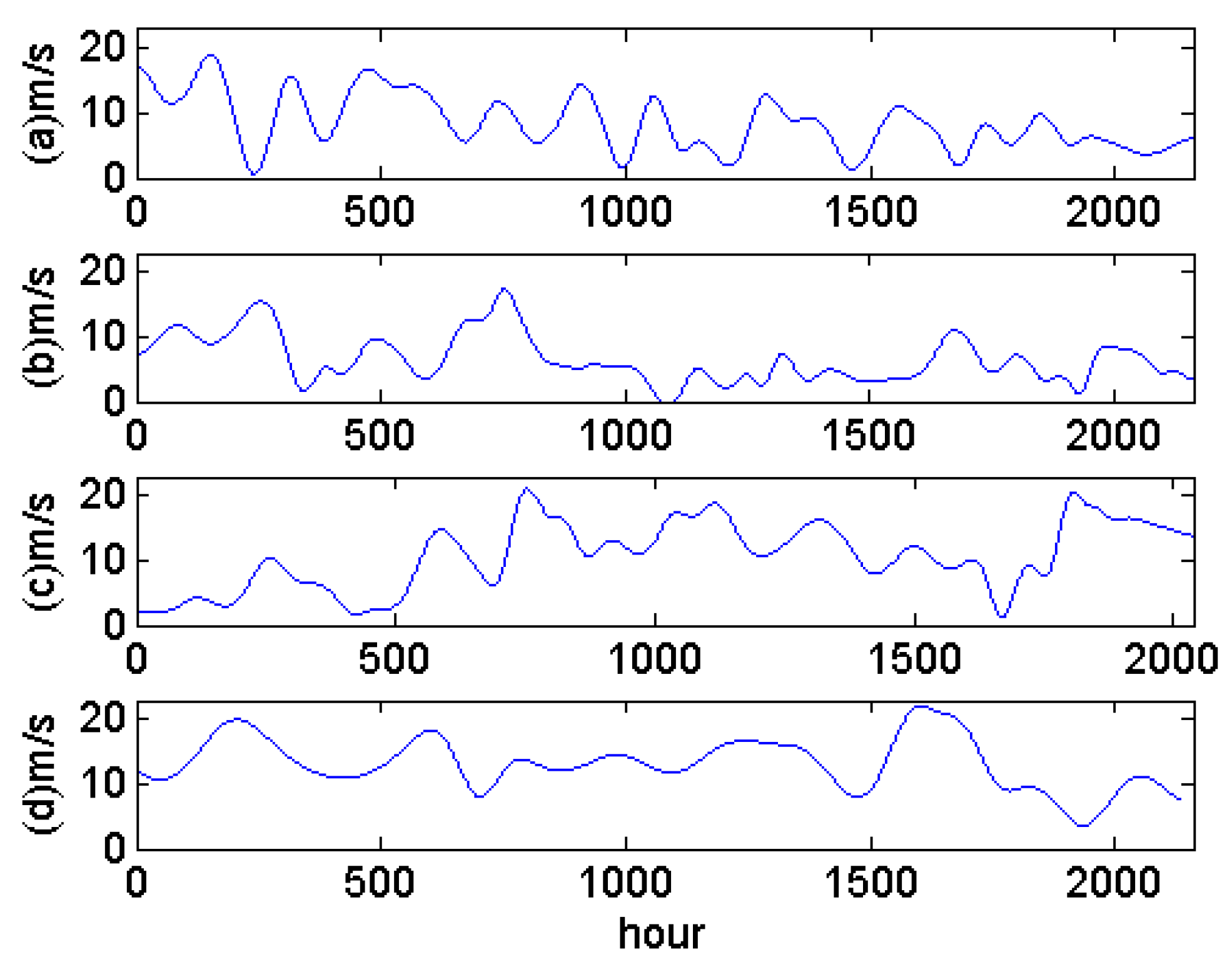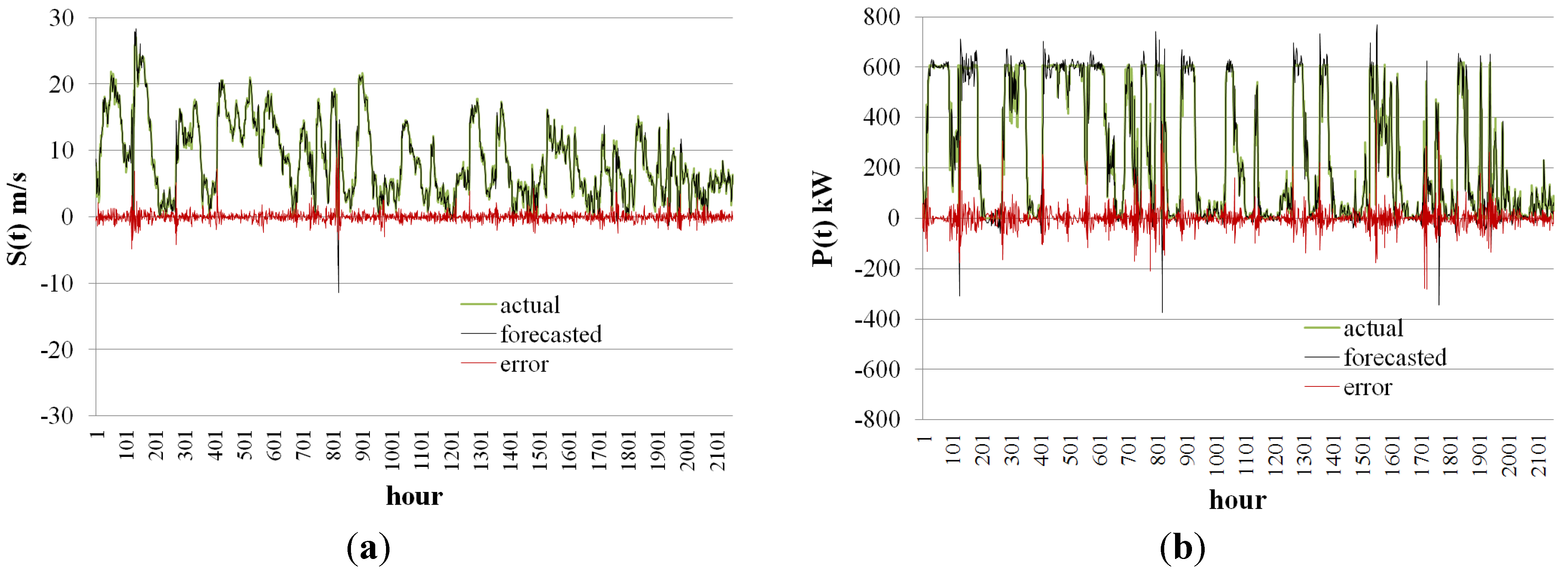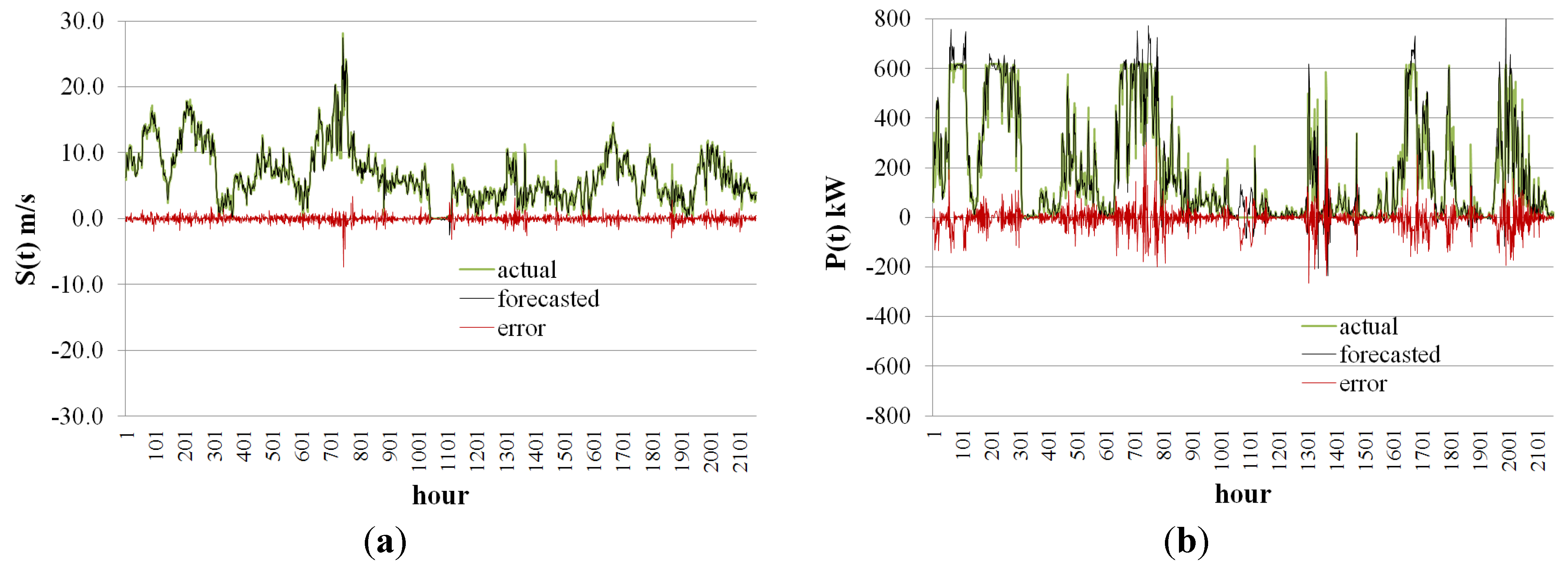Many countries have recently established roadmaps to implement their visions of smart grids. One of the principal characteristics of a smart grid is that a smart grid should accommodate all generation and storage options. “All generation options” covers environmentally friendly sources, including wind and solar photovoltaic farms [
1]. Advantages of the renewable energy sources consist of reduction of traditional fossil-based generation expansion and mitigation of greenhouse gas emissions. However, an increase of renewable penetration in transmission or distribution systems may incur in new operation problems, e.g., protective relay setting and unit commitment. More specifically, the differential relay may malfunction due to a change in the line flow direction; reserves of traditional fossil-based generation may be inadequate because of inaccurate renewable power generation forecasting. This paper addresses short term (
i.e., one hour ahead) wind speed/power forecasting which provides a valuable infrastructure for power system operation-related studies.
Forecasting problems have received considerable attention for several decades. Among all, load forecasting methods are well-developed [
2,
3,
4,
5,
6]. Related applications include load management in microgrids [
2], planning and operational decision making of utility companies [
3,
4,
5], and energy efficiency improvement in buildings [
6]. A recent work addressed how short-term solar irradiance forecasting focuses on account of great significance for the optimal operation and power predication of grid-connected photovoltaic (PV) plants [
7]. However, wind speed and power forecasting is more difficult than system load and solar irradiance forecasting [
8]. Wind power forecasting methods can be categorized as long-term (
i.e., more than six hours ahead) [
9,
10,
11] or short-term (
i.e., from several minutes up to six hours ahead) [
12,
13,
14,
15,
16,
17]. In particular, Anastasiades and McSharry developed quantile regression models to generate short-term probabilistic forecasts from 15 min up to six hours ahead [
12]. Zhang
et al. [
13] integrated univariate least squares support vector machine (LS-SVM), hybrid models by using auto-regressive moving average (ARMA) and LS-SVM and multivariate LS-SVM models to obtain the short-term (hourly) forecasting using the fuzzy aggregation and defuzzification procedure. Catalão
et al. [
14] extracted detailed/coarse components from the wind power time series by the wavelet multilevel decomposition/reconstruction procedure and then applied adaptive-network-based fuzzy inference system (ANFIS) to conduct short-term (3 h ahead) forecasting. Potter and Negnevitsky [
15] also used ANFIS to perform very short-term (2.5 min ahead) wind power forecasting through the wind speed and direction. Amjady [
16] used an irrelevancy filter and a redundancy filter to identify features for neural networks trained by particle swarm optimization to forecast hourly wind power. Khosravi
et al. [
17] investigated two neural network-based methods for direct and rapid construction of prediction intervals (PIs) for short-term (5, 10, 15 and 30 min ahead) forecasting of power generation in wind farms. Li
et al. [
18] presented a method to combine three forecasted results obtained by three different neural networks, namely, adaptive linear element network (ADALINE), backpropagation (BP) network, and radial basis function (RBF) network using Bayesian combination algorithm. Amjady
et al. [
19] used mutual information criteria to identify essential candidate inputs first and then used a ridgelet neural network trained by differential evolution algorithms. Liu
et al. [
20] took advantage of the wavelet transform to decompose the wind power time series and used ARIMA to be a forecaster. Jursa and Rohrig [
21] used the mean output of the neural network model and the nearest neighbor search to conduct hourly wind speed/power forecasting. Zhou
et al. [
22] implemented three different support vector machine (SVM) kernels, namely linear, Gaussian, and polynomial kernels, to perform hourly wind speed/power forecasting. The above description reveals that previous works can be further improved:
- (i)
Complex forecasters, in which the sophisticated neural network, fuzzy reasoning and population-based optimization were used, were developed in order to attain the results [
12,
13,
14,
15,
18,
19,
21,
22];
- (ii)
Essential parameters were not identified first in order to carry out forecasting [
12,
13,
14,
15,
17,
18,
20,
21,
22];
- (iii)
Very short term forecasting studies were conducted in [
15,
17]. Actually, the traditional simple persistence method competes with these complex methods [
15,
17] while very short term forecasting is studied;
- (iv)
Mother wavelets must be implemented by a trial-and-error method in [
14,
20]. The number of multiple resolutions needs to be determined heuristically, too; and
- (v)
Complex data preprocessing using the irrelevancy filter and redundancy filter [
16] or mutual information criterion [
19] was performed.
Based on the above discussion, this paper proposes a novel method that integrates the correlation coefficient, empirical mode decomposition (EMD) [
23] and back-propagation-based (BP-based) neural network to conduct the short-term (one hour ahead) wind speed and power forecasting. The correlation coefficient is adopted since short-term forecasting is of concern rather than a long-term investigation. EMD can extract symmetry-like low-order and smooth high-order intrinsic mode functions (IMF) from the original signal. In contrast to multi-resolution analysis in [
14], EMD does not need the mother wavelet and can decompose the signal (time-series) with a pre-specified tolerance. Because the attribute of IMF is well-behaved, the forecasting is performed using the relatively simple BP-based neural network rather than the sophisticated neural networks used in [
13,
14,
15,
19,
22].

